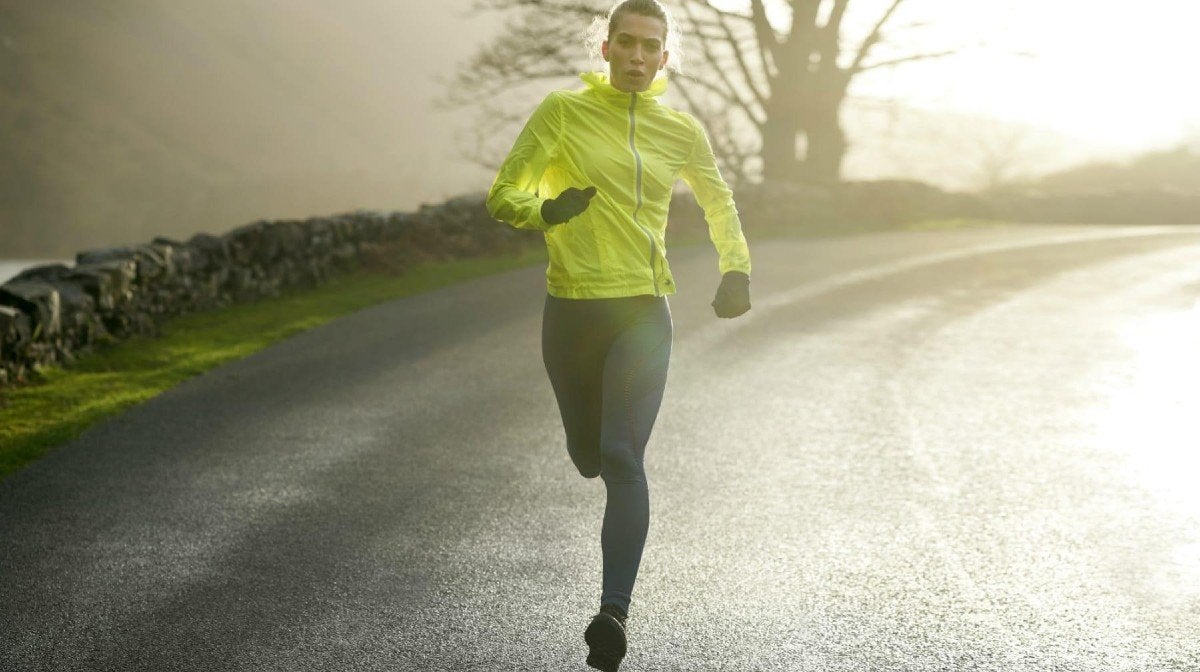
What Is The Difference Between Jogging And Running?
Jogging is often performed at a lower intensity than running, which means it can also be performed for a longer duration. Subsequently, running uses more energy as your skeletal muscles, lungs and heart must work harder. Due to the difference in intensity, jogging is a reasonable activity for almost everybody to try.
Why You Should Try Jogging
With gyms closed, the benefits of jogging cannot be overstated for your mental or physical health. The best part is that you don’t need to have been an avid gym-goer prior to lockdown to start. Getting out for a jog can provide the perfect escape, allowing for a small bit of socialisation – and starting with a light jogging pace will always beat not being out at all!
1. Jogging Can Boost Your Immune System
While excessive exercise is known to inhibit the effectiveness of your immune system, sustainable and moderate-level activity such as jogging can improve the effectiveness of your immune system. It is well documented that individuals who regularly undertake even just low intensity jogging each week have a lower mortality rate than their sedentary counterparts. A 2020 study by Khamassi et al. tracked biomarkers in a group of healthy young men during high-intensity interval training and moderate steady-state activity and found that moderate-intensity sustained exercise (i.e. jogging) resulted in improved immune function compared to the HIIT group.
Joggers are also likely to follow ‘health-seeking behaviours’ – often exhibited by more active individuals (i.e. those who wish to improve at or undertake jogging are less likely to be smokers, have healthier diets and have longer and better quality sleep – all of which are known to reduce morbidity risk factors).
2. Jogging Can Help To Look After Your Mental Health
Exercise releases endorphins which interact with opiate receptors in the brain, leading to reductions in perceived pain and a sensation of well-being. The benefits of exercise for your mental health are well documented, with one 2013 study by Cooney et al. outlining that exercise can be an effective way of managing depression. Of course, there are further implications associated with exercise like jogging, such as the positive effects of being outdoors, seeing other people and improving your body image and thus increasing your self-esteem. All of these factors are known to improve or manage your mental health, and they all stem from exercise – not to mention the physical benefits that improve your physical health along the way.
3. Improve Your Cardiovascular Fitness
It’s no secret that jogging and running will improve your cardiovascular fitness (and local muscular endurance – meaning specific muscle groups are able to perform repeated low- intensity contractions for a sustained period before succumbing to fatigue.
4. Burn Calories
All forms of activity require calories from food to be used as fuel. The intensity and duration of the exercise will dictate how many calories will be used, although jogging is a reliable way to ensure you burn at least a few hundred calories (at the time of the exercise). You’ll then burn more calories when resting or doing your daily activities for the rest of the day as your body returns to its normal resting metabolic rate (although this elevation may not be huge over one day, the numbers certainly add up as you continue to incorporate jogging into your routines).
5. Strengthen Muscles and Improve Bone Density
There are a lot of reasons to want strong muscles over weak ones – they look better, they assist you in daily activities and they reduce the risk of injury. This is especially important for older and ageing populations since a process known as sarcopenia occurs – the natural loss of muscle with ageing. Physical activity can help to offset the effects of sarcopenia, and the loading experienced during jogging helps to increase bone density, which is important for preventing bones from fracturing due to things like falling over.
6. Socialisation
For now, you may only be able to go on a socially distanced run with one other person, but jogging can ultimately be an extremely sociable activity to get in to. You can often find and meet new runners through events like Park Run – a local weekly event all around the UK which is set to get people active together for free. It’s also highly likely that there is some form of a running club that is very local to you, which often have runners of all abilities present, so there is always somebody to run with you in the group.
7. Competition
Once you’ve got ‘the bug’ (for jogging and running, not corona!), you might want to set yourself goals such as running your first 5k race. Of course, it’s often not about the race itself, but the satisfaction of reaching a goal before progressing further. For the most part, races are being cancelled due to current circumstances – however, there’s no doubt the community is still thriving, so this could be the ideal time to start getting the miles in!
How To Start Jogging
As with many things, the hardest part is often simply getting started. Here’s a quick go-to list to help you prepare to start jogging, and make sure you get started on the right foot!
1. Make Sure You’ve Got The Right Gear
It’s important to make sure that you have the correct gear for jogging – and it’s particularly important to dress appropriately for the weather during this time of year. For the basics, you’ll need appropriate footwear and comfortable clothing that you can jog in. For something more specialised, consider the surfaces you will be jogging on when choosing your footwear. Your feet are built for running, so the less squishy and padded the trainers are, the better.
Jogging specific clothing like leggings will help to keep your legs warm through the winter, and a high visibility jacket will protect you from the elements while making yourself more visible to traffic. Jackets don’t need to be highly insulated, as your body temperature should do the work for you – but it’s certainly a valuable investment during the colder and darker months!
Smartwatches designed for jogging will use GPS to track the distance covered and give you an accurate estimation of the calories burned based on the amount of time it took you to cover your chosen distance. Most also monitor your heart rate throughout your session, so they can be a great tool for tracking your progression. Don’t worry if you don’t want to fork out for a new gadget right now though, as most smartphones are able to do the basic functions like GPS tracking your distance and time.
2. Grab A Jogging Partner
Often, it is difficult to motivate yourself, particularly when it is a new goal that you are chasing. Try to find a like-minded friend that is willing to join you (current lockdown rules stipulate that you can meet up with one person outside of your household whilst socially distanced, when not in a garden). Not only could this help you to achieve your goals, but it could also provide some much-needed social interaction that can help improve your mental health.
3. Plan Routes In Advance
Planning routes in advance allow you to follow a safe and familiar route, whilst also knowing the exact distance you’ll cover (this can help with progression, as you will be able to cover the same routes in a quicker time as you continue to progress!). If you are familiar with an area, you may be able to just jog for a certain distance/time in one direction, before turning back at the halfway point. Apps like Strava can show you commonly used running routes in the area and can also introduce a bit of friendly competition between yourself and friends!
4. Set Goals
You can use your friends and Strava to help motivate yourself with this one. Setting SMART goals (Specific, Measurable, Achievable, Realistic and Time-constrained) will help you to progress at a reasonable pace, as you will always be trying to one up yourself. Partner this with a responsible training and recovery protocol, and you’ll be well on your way to success!
5. Allow Sufficient Time For Recovery
Everybody needs enough rest between sessions in order to recover and adapt to the training stimulus, no matter what level they are at. You may find that if you are completely new to this form of exercise, then you will experience particularly bad DOMS (Delayed Onset of Muscle Soreness) 1 to 2 days after the exercise bout. This is because novel exercise stimulus tends to elicit more muscle damage, since the muscles used may not usually be trained in that manner. As a novice, 2-3 jogs per week may be enough as your muscles and cardiovascular system will need time to adapt.
With more experience, you may progress to 4-5 per week before even making it daily. The quality of your training will always be highly dependent on the quality of your recovery, so ensure you get enough good quality sleep and eat a high protein diet.
How To Tell If You’re Jogging Incorrectly
As with any form of exercise, your body will tell you whether something is ‘good pain’ (e.g. burning sensation in your muscles from lactic acid build-up) or if it’s ‘bad pain’ (e.g. limping when trying to jog on a sprained ankle). If you experience pain or discomfort during exercise that can’t be attributed to muscle damage and fatigue from the exercise itself, then you should cease the activity until you can get a professional opinion with appropriate treatment, so that you do not exacerbate any existing conditions.
1. You Have A Sore Neck
The upper fibres of the trapezius muscle (along with many other smaller muscles) are responsible for elevating (shrugging) your shoulders. It may be that you are not keeping your shoulders relaxed whilst you are jogging, and thus overworking your trapezius muscle, which may lead to spasm and pain later. To prevent this, try to relax your shoulders when jogging, and maintain an upright posture so that the muscles around your neck and shoulder are not made to do more work than is necessary.
You may also find that direct strengthening exercises like dumbbell shrugs will help by strengthening the trapezius muscle which supports your neck. Finally, in these colder months, consider a running jacket with a hood or a neck warmer, since warmer muscles will feel less tense and more mobile.
2. Your Knees / Ankles Hurt
The way you walk, jog, run or sprint is known as your gait. There are many points along the kinetic chain that is your legs/pelvis where some form of deficit can be responsible for mechanisms that may result in pain or discomfort. For instance, a common fault is known as ‘genu valgum’ results in your knees coming towards your midline instead of tracking forwards as you run, which in turn, can put unnecessary strain on structures like your ligaments in surrounding joints.
Some running shops (or certainly physios who see a lot of runners) will perform a ‘gait analysis’, where they can give you some technique tips and help to guide you to purchase an appropriate pair of trainers. Steps that you can take include performing strengthening exercises for the muscles around the hip (specifically, the gluteus medius muscle) which provide stability to joints further down the kinetic chain. Ultimately, this means that the loads experienced when jogging will be more effectively absorbed by your muscles, instead of being forced into structures that are only there to provide secondary support.
3. You Are Struggling With Your Breathing
There are many reasons why you may struggle to breathe when running, which might include allergies, heat, humidity or something like asthma. It may even be as simple as jogging at a pace that is slightly too fast for your current abilities, thus your heart and lungs are not able to keep up with the demands from your muscles.
Try starting with a slower pace, breathing through your nose – this will ensure that you are not pushing yourself too hard. As a long-term solution to the problem, you should try to establish a comfortable rhythmic breathing pattern (e.g. exhaling every time your left foot strikes the ground).
4. Your Muscles Are Tight
First, you need to find out which muscles are tight, and whether they are even tight at all! In some cases, muscles that feel tight may in fact not be strong enough. Due to this, an effective approach would be to combine moderate static and dynamic stretching with direct resistance training to the affected muscles. Try not to hold static stretches for long periods of time to combat feelings of tightness, as research has found that this may reduce the power output of the muscles being stretched.
Take Home Message
During times like these, where we’re in and out of lockdowns and gyms are forced to close at short notice, it’s important to still get plenty of physical activity. Not everybody is interested in training for big muscles, but everybody has a heart that needs to be kept healthy. Jogging may prove to be the perfect outlet for many, as it is not costly, it can be sociable, and it gets the body moving. Jogging may even turn out to be the activity that you never knew you loved to do!












